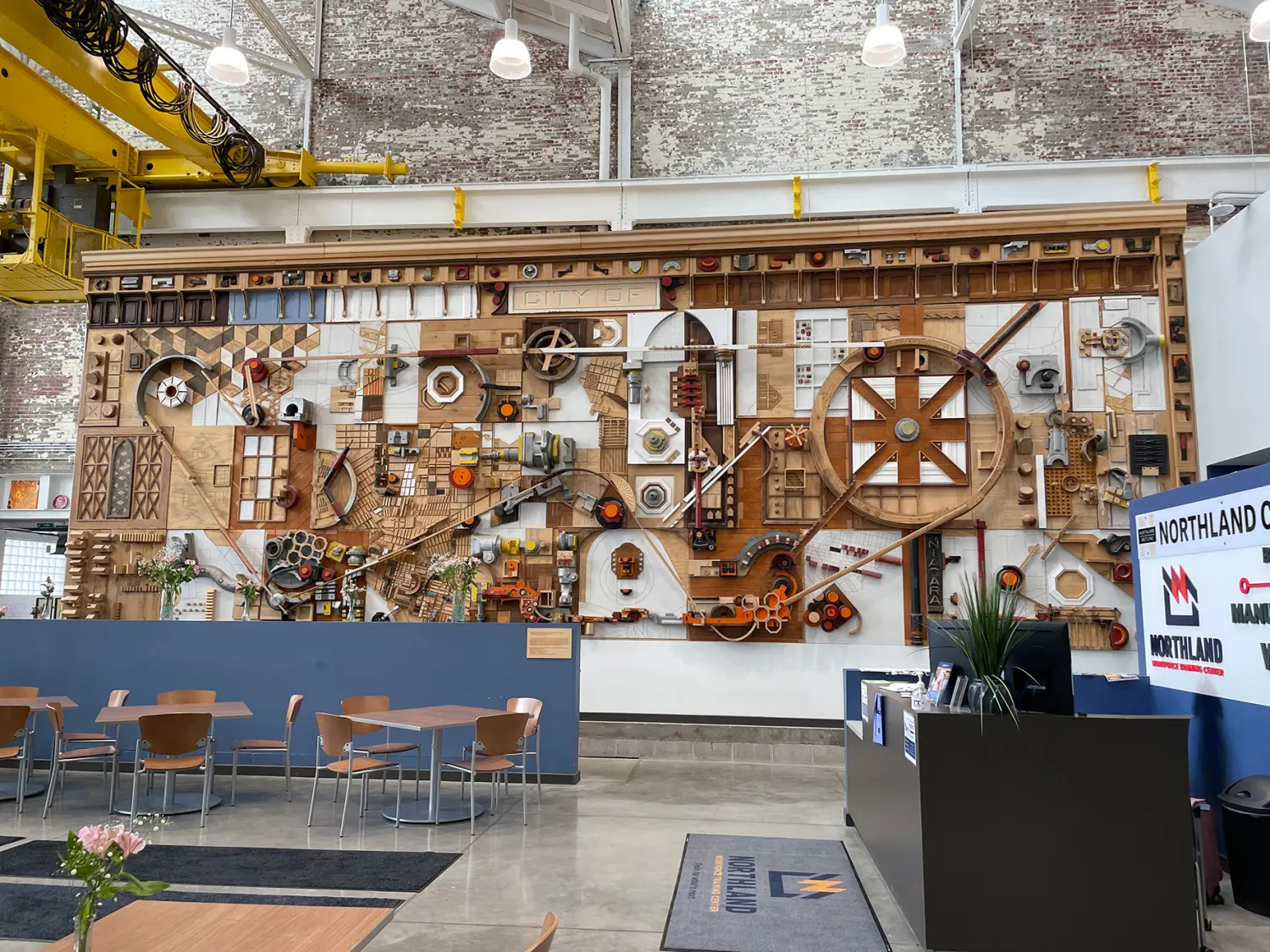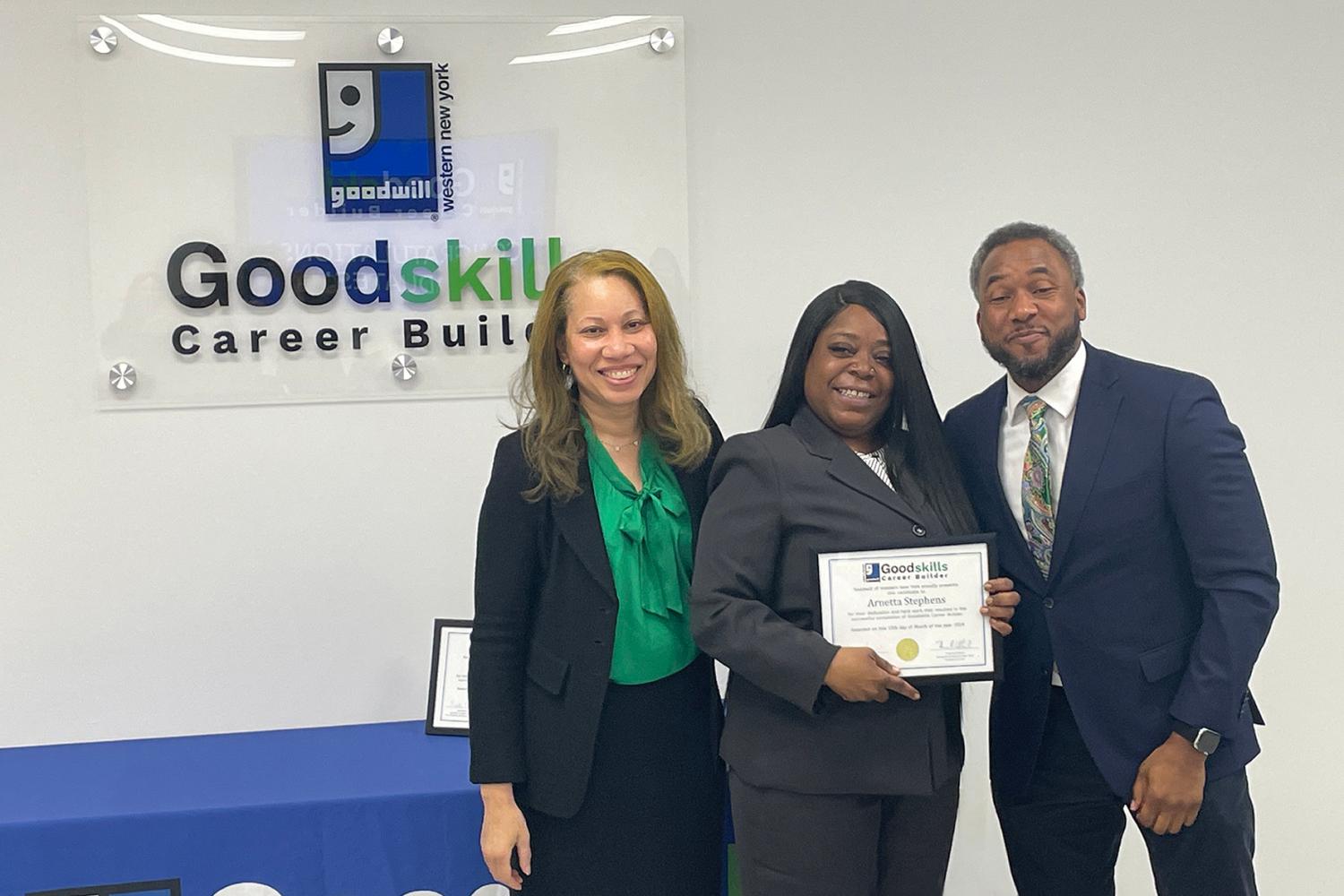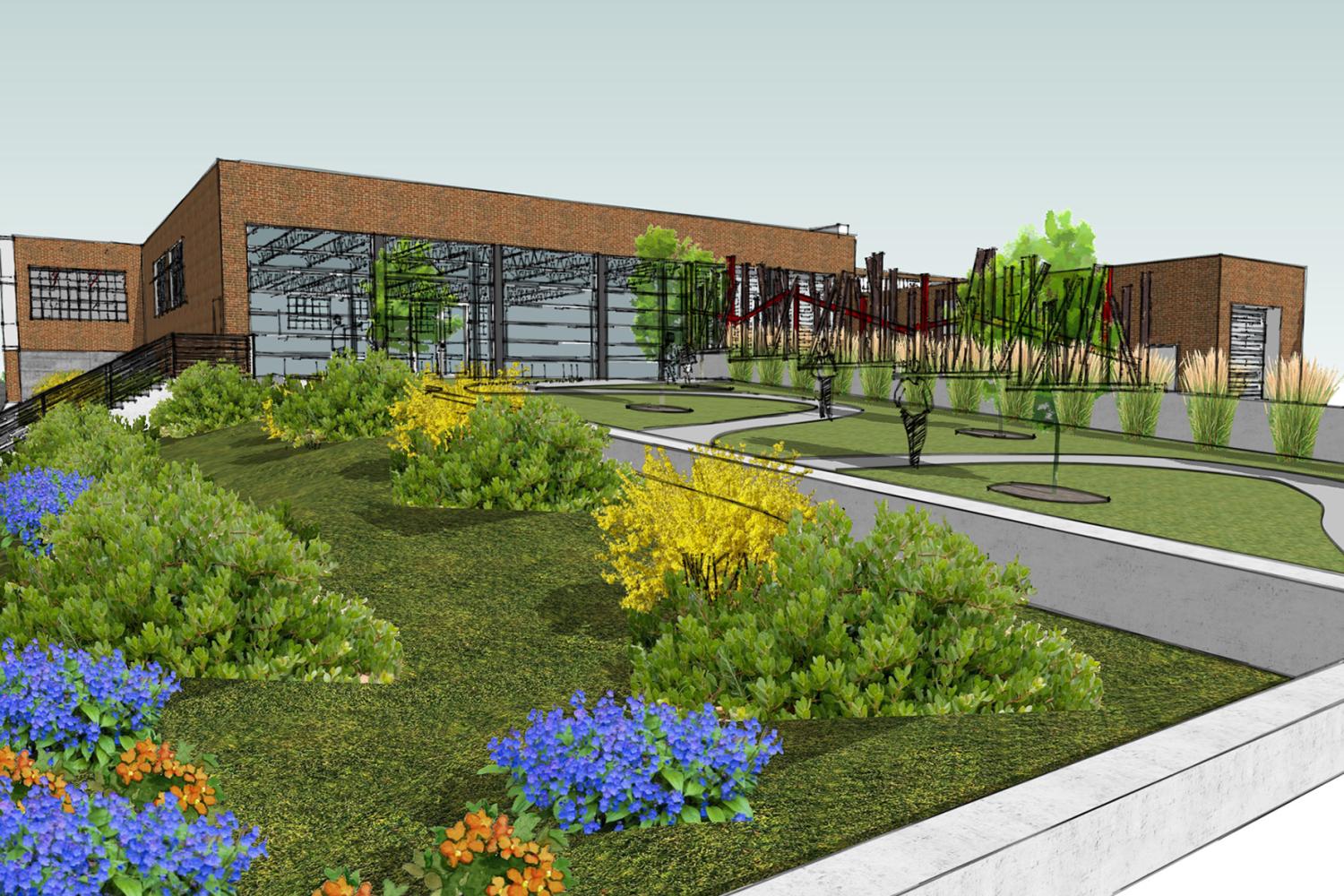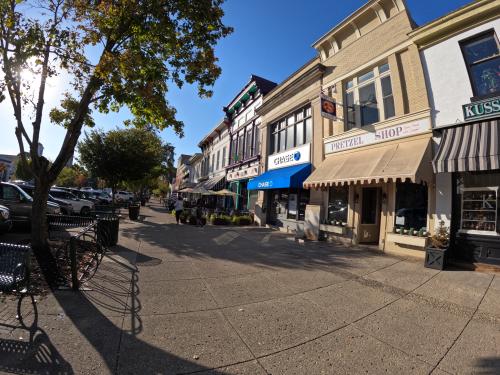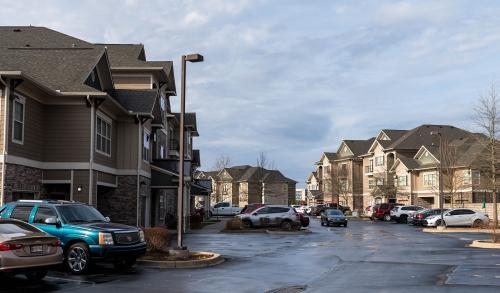The one-minute version of this case study
- Western New York’s advanced manufacturing cluster is gaining traction. Anchored by the Rust Belt city of Buffalo, the Western New York (WNY) region has a long history in steel and other industrial manufacturing. In 2012, the state launched the Buffalo Billion—a billion-dollar investment to jump-start innovation and economic and workforce development across WNY. Today, advanced manufacturing presents a key opportunity for quality job growth, with some sub-sectors expected to grow by more than 20% between 2022 and 2032—far outpacing the rest of the nation.
- The region’s core challenge—and opportunity—is reaching untapped talent. While the number of advanced manufacturing and other tech-enabled jobs is growing rapidly in WNY, many are going unfilled. Like other places across the nation, an aging workforce and looming retirement cliffs threaten WNY’s manufacturing sector. Meanwhile, the region’s urban-rural divide across counties, as well as patterns of racial segregation and disinvestment within counties, leave thousands without access to these opportunities.
- The region’s Build Back Better Regional Challenge (BBBRC) coalition and a related coalition focused on talent development are helping WNY address both local and regional inequities. The Western New York Advanced Manufacturing coalition’s $25 million BBBRC strategy aims to grow advanced manufacturing cluster opportunities on Buffalo’s East Side, while the WNY Manufacturing and Tech Workforce Coalition focuses on workforce development and encompasses both the advanced manufacturing and tech sectors. Both coalitions are designed to counter historical patterns of concentrated disinvestment and extend inclusive growth opportunities to more rural and remote areas across WNY’s Southern Tier.
- Federal funding is just one piece of a longer-term regional strategy. This case study explores the design and implementation of BBBRC WNY Advanced Manufacturing coalition programs (the expansion of short-term job trainings into low-income rural areas, technology adoption support for small and midsized manufacturers, and rehabilitation of industrial buildings), as well as the synergistic $29 million WNY Manufacturing and Tech Workforce Coalition, funded by the state and philanthropy. This case study offers lessons about how regional partners are leveraging the combination of federal, state, and philanthropic funding to execute a broader regional strategy.
Before reading this case study: What is the Build Back Better Regional Challenge?
This brief overview of the program provides useful context before reading this case study.
In July 2021, the Economic Development Administration (EDA) launched the $1 billion Build Back Better Regional Challenge (BBBRC) through a Notice of Funding Opportunity that outlined a two-phase competition.1 Through its Phase 1 activities, the EDA issued an open call for concept proposals that outlined a high-level vision for a “transformational economic development strategy.” The thesis was that regions would identify an industry cluster opportunity; design “3-8 tightly aligned projects” to support that cluster; build a coalition to “integrate cluster development efforts across a diverse array of communities and stakeholders”; and ensure that these collective efforts advance equity by supporting economically disadvantaged communities.2
In Phase 1, 529 coalitions submitted high-level concept proposals that outlined a vision for the cluster, a high-level description of potential projects, and the key institutions involved in the coalition. After receiving Phase 1 concept proposals, the EDA undertook two months of review to determine which coalitions would be awarded $500,000 technical assistance grants and invited to apply for Phase 2 funding. Those resources enabled a hyper-intensive planning sprint between December 2021 and March 2022. During this period, each of the 60 finalist coalitions expanded their five-page concept proposal into an overview narrative and project proposals that outlined their approach, key assets and institutions, the portfolio of projects and their expected outcomes, and matching resources to complement the EDA grant.
Ultimately, the 60 coalitions submitted funding requests well beyond the BBBRC’s $1 billion allocation. The average Phase 2 funding request submitted to the EDA was approximately $75 million, while the average award amount available in the competition budget was approximately $50 million. Given this gap, in May 2022, all 60 applicants were offered the opportunity to prioritize funding through a budget request reduction process after applications were received. Then, an Investment Review Committee (IRC) assessed all completed applications and made recommendations. In some cases, the EDA ultimately selected a subset of component projects for funding or funded component projects at a reduced level, requiring applicants to modify projects during the award process. In September 2022, the EDA selected 21 of the 60 coalitions for implementation awards, ranging in size from $25 million to $65 million, to be spent over a five-year period.

Background
Historical context: Buffalo’s rise and decline as the ‘Gateway to the West’
Buffalo, N.Y. is a quintessential legacy city that originally gained prominence in the mid-1800s as the western terminus of the Erie Canal, which opened in 1825. During this time, Buffalo earned its title as the “Queen City of the Great Lakes” and became the world’s fourth-largest port. Also called the “Gateway to the West,” Buffalo functioned as a critical trans-shipment point between lake vessels and canal boats (and later to railroad cars). As regional rail access grew, the city became a center of grain distribution, and it maintains its status today as the second-largest city in New York.
At its height in the first few decades of the 20th century, Buffalo and its surrounding area were involved in a combination of railroad commerce, basic steel production and fabrication, automobile production, aircraft/aerospace design and production, shipping, and grain storage. As a center of industrial growth, Buffalo also attracted world-class architects—still evident today with the existence of America’s oldest coordinated system of public parks and parkways, which winds its way throughout the city. Owing to this industry growth, Buffalo experienced a population boom in the 1940s and 1950s—a significant portion of which consisted of African Americans migrating from the rural South in search of jobs. However, opportunities were limited by racial, economic, and political discrimination, including local lenders and federal agents instituting redlining, which funneled government-backed mortgages to white neighborhoods and away from neighborhoods with residents of color—ultimately curtailing wealth-building opportunities across the city.
Buffalo’s economic role evolved as technology and transportation shifted. Rail became increasingly efficient, and new transportation systems reduced the importance of the Erie Canal. In 1959, the opening of the St. Lawrence Seaway established a direct connection between the Great Lakes and the Atlantic Ocean—effectively eliminating the need to pass through Buffalo at all. As the city’s geographic advantage waned, the majority of Buffalo’s heavy industrial establishments closed down, while others migrated from the downtown core to the suburbs or relocated to parts of the U.S. South and abroad.
We have a legacy of manufacturing in our region—a strong history in it. I think it remains an important part of our economy. Our economy shifted pretty drastically with the closing of Bethlehem Steel and places like that…If you’re overly dependent on any one piece of the economy, that’s what sort of crushed us after the closing of Bethlehem Steel. So many jobs went with that.
Laura Quebral, Center for Regional Strategies
Buffalo’s population peaked in 1950, when it was the 15th-largest city in the U.S. It then entered a long period of job loss and sustained economic decline. Investments in regional expressways—including the Niagara Thruway and the Scajaquada and Kensington expressways, which at the time were considered necessary investments to maintain the city’s competitiveness—displaced thousands of residents while the remaining central city infrastructure was left to crumble. These expressways also enabled “white flight” from the city for those who could afford to commute, resulting in a more economically and racially segregated region.
Today, Buffalo and the broader WNY region continue to grapple with high levels of poverty and geographic segregation, with notable disparities both within and across WNY counties. First, while 13% of Erie County residents are living in poverty, the city of Buffalo has a poverty rate of 27%—one of the highest in the nation. That poverty is concentrated in the city’s East Side, with more than half of individuals living in or near poverty. This concentration of poverty is highly racialized; over 85% of the city’s Black residents live on the East Side, owing to a history of redlining and other racially discriminatory government and business policies and practices that deliberately excluded the East Side and its predominantly Black neighborhoods from home loans, access to capital, and broader economic investments.
But that is not the region’s only challenge: WNY is also characterized by a sharp urban-rural divide. The region’s Southern Tier—Allegany, Cattaraugus, and Chautauqua counties—historically has been disconnected from Buffalo’s economic ecosystem. With many new investment and attraction efforts focused on the city of Buffalo and Erie County, Jamestown and other rural areas in the Southern Tier have not traditionally been part of regional development efforts. “Sometimes, when bigger things happen in the Buffalo area, we get overlooked,” said Holger Ekanger, vice president for workforce development at Jamestown Community College.
Investing in Western New York’s economic future
By the early 2010s, it was clear that WNY needed a major intervention to both strengthen the region’s advantages in industries creating quality jobs and address decades of rising economic and racial inequality. Regional assessments have revealed that advanced manufacturing and technology sectors are key sources of quality job growth. The advanced manufacturing sector remains a core driver of the regional economy, offering higher-paying career pathways even for workers without degrees. Manufacturing jobs in WNY are expected to grow 12% over the next decade. Meeting or exceeding this trajectory, however, requires that the region address various challenges the sector faces: a talent pipeline threatened by an aging workforce and significant racial disparities; declining employment at younger manufacturing firms; and aging factory facilities and infrastructure. The tech sector, while more nascent than manufacturing, is projected to grow five times as fast as the rest of the WNY economy over the next decade. Yet half of all tech jobs in WNY are currently going unfilled, suggesting training programs can help fill this gap. Importantly, there are growing synergies between tech and manufacturing, with a recent study concluding that manufacturing is one of the region’s largest tech-enabled sectors.
We just know that we’ll fall behind if we don’t think about tech as part of our economy. It is cross-cutting across the sectors, and we will fall behind if we can’t fill those jobs. And again, there’s a lot of overlap between manufacturing and tech, so we really wanted to be thoughtful about the future, thinking about where manufacturing is headed.
Laura Quebral, Center for Regional Strategies
Understanding these trend lines, the state of New York—in tandem with non-governmental actors—has made considerable investments in the WNY economy over the past decade. The most prominent of these efforts—the Buffalo Billion—was launched in 2012 by then-Governor Andrew Cuomo. Led by Empire State Development (ESD), the state’s economic agency, the Buffalo Billion strategy has resulted in $1.5 billion in new public investment since 2012 in service of a regional economic development strategy.
The Buffalo Billion funded multiple new intermediaries intended to collectively jump-start industry growth and workforce development in WNY, including: Northland Workforce Training Center (workforce training); 43North (startup accelerator); Launch NY (venture capital); and Buffalo Manufacturing Works (business innovation center). These investments required new collaborative structures, including the formation of the WNY Regional Economic Development Council, which covers the five-county region. It also required new operational capacity, with the University at Buffalo Regional Institute (UBRI) offering project management support across approximately 40 initiatives and over 100 individual projects.
Buffalo Billion is a regional strategy, but it did target major investments in the East Side in an attempt to strengthen industrial competitiveness and extend opportunity to historically excluded communities. The Northland Workforce Training Center (NWTC) and Buffalo Manufacturing Works (BMW), for example, both opened in revitalized East Side buildings, with the hope that their physical location combined with intentional community outreach could connect neighborhood residents to training and job opportunities. NWTC and BMW are part of a uniquely comprehensive government-philanthropic collaboration called East Side Avenues, which is also supporting small business improvements, redeveloping key mixed-use properties, promoting historic preservation, reinvigorating fundamental anchors, and building capacity for nonprofit partners to implement this critical work.
By 2021, this economic approach—one that seizes emerging industry opportunities at a regional scale and addresses concentrated poverty and racial inequality at a neighborhood scale—was an important foundation for assessing the relevance of the BBBRC.
Coalition formation
This section explores how leaders from across the five-county WNY region came together to form two coalitions with several overlapping organizations: 1) the EDA-funded Western New York Advanced Manufacturing (WNYAM) coalition, comprised of a portfolio of BBBRC projects; and 2) the Western New York Manufacturing and Tech Workforce Coalition (WNY MTW Coalition), a state and philanthropic initiative founded on years of regional collaboration supporting a wide range of programmatic and systemwide investments in workforce development. How these two coalitions emerged will be of interest to civic leaders, state policymakers, and philanthropic investors in other regions that are considering how state and philanthropic funding can complement federal place-based strategies.
Aligning a coalition around a project portfolio
The WNYAM coalition’s eventual selection of the advanced manufacturing sector can be traced to similar factors and data analysis that informed the Buffalo Billion investments. Even through the sector’s challenges during the late 20th century, manufacturing remains a central driver of WNY’s innovation and exports. Yet manufacturing in the region is shifting to become more “advanced,” meaning more reliant on digital technologies such as robotics, advanced materials, and complex software systems. As these technologies become integrated across small and midsized manufacturers (SMMs), employment in these companies requires new technical skills. Given these emerging changes, the region’s BBBRC proposal sought to harness the opportunity to shift the perception of manufacturing—particularly in the eyes of younger people—from “dark and dirty” to a new reality involving higher-quality, tech-related jobs. Indeed, the average annual earnings in advanced manufacturing is over $70,000, which is 25% more than the average job in WNY.
The BBBRC Phase 1 application allowed the major architects of the Buffalo Billion strategy—UBRI and ESD—an opportunity to address the emerging challenges and opportunities in advanced manufacturing. Drawing from the Buffalo Billion strategy, the coalition proposed seven projects along three investment pillars: innovation, workforce, and infrastructure and governance (* indicates a project received implementation funding).
- Small and midsized manufacturer (SMM) technology program*: Buffalo Manufacturing Works (BMW), an advanced manufacturing innovation center operated by EWI, would promote technology adoption at SMMs.
- Hardware Startup Acceleration: University at Buffalo Business and Entrepreneur Partnerships (UB BEP) would create a three-stage hardware accelerator program to support potential hardware founders.
- Goodskills Career Builder*: Goodwill of Western New York would expand recruitment for Goodskills Career Builder, an existing four-week workforce training program, into low-income rural areas outside of Erie County.
- WNY Clean Energy Infrastructure and Manufacturing Regional Partnership: Northland Workforce Training Center would expand its community-centered workforce training model to Jamestown and Niagara.
- Buffalo Urban Development Corporation (BUDC) Phase 3*: BUDC would redevelop three significant industrial buildings, complete a clean energy microgrid, and enhance infrastructure to create leasable space for local manufacturers and workforce training opportunities.
- Accelerating Local Manufacturing Expansions: Invest Buffalo Niagara would address demand for developable manufacturing space to grow local SMMs.
- Project Implementation Team: ESD’s regional office and the WNY Regional Economic Development Council, in partnership with UBRI, would manage coordination, collaboration, and communication to ensure strong cohesion across the coalition and maintain industry engagement as well as core principles of equity and sustainability.
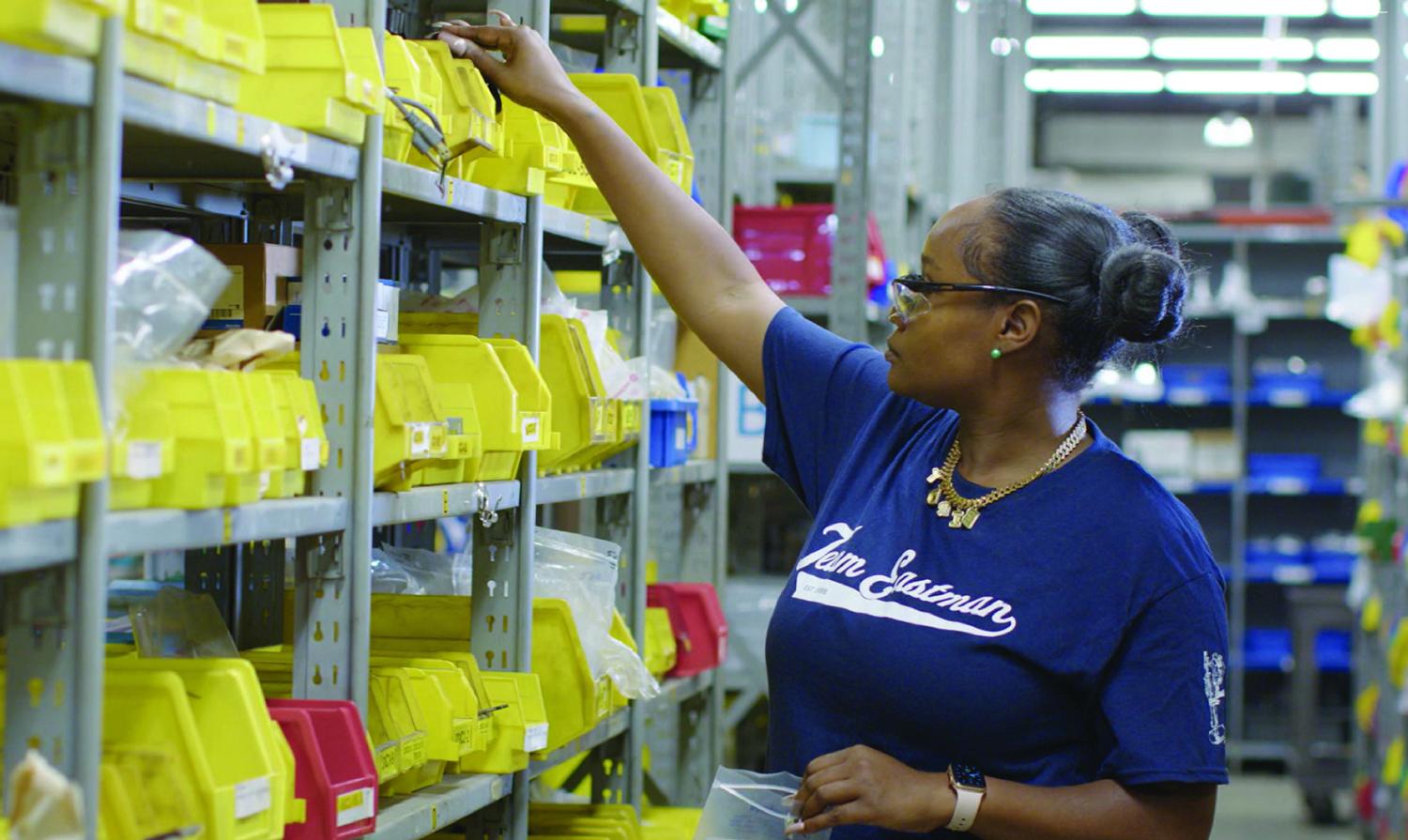
This project portfolio sought to address racial and geographic inequities across the region. Within the city of Buffalo, the equity strategy focused on addressing racial and economic disparities—primarily on the East Side—through additional investments in innovation, workforce development, and infrastructure. WNYAM also sought to ameliorate rural poverty and overcome heightened barriers to workforce participation due to transportation, limited availability and/or access to social services, and structural barriers. While initially focused on the cities of Buffalo and Niagara Falls, the Manufacturers Association of the Southern Tier (MAST) and NWTC advocated that the coalition include projects from the three counties (Chautauqua, Allegany, Cattaraugus) in the rural Southern Tier.
Regional stakeholders viewed the BBBRC as a key opportunity to expand their initiatives and accelerate progress toward their organizational and regional goals. Paul Tronolone, vice president of policy and planning at ESD, described the BBBRC as “big programs…that allow us to do things that we started.” Henry Cialone, president and CEO of EWI (the operating entity for BMW), agreed, calling the BBBRC “jet fuel to get us faster where we were going anyway.”
With this seven-project approach, WNYAM was selected as one of the BBBRC’s 60 Phase 2 finalists (out of 529 coalitions competing for this designation in Phase 1). Since Phase 2 funding requests exceeded the BBBRC’s available resources, the EDA gave all Phase 2 finalists, including WNYAM, the opportunity to reduce their budgets. The group submitted a revised proposal for all seven projects, and the Investment Review Committee selected three for implementation awards, for a total award of $25 million:
- Innovation: Building on BMW’s existing “Shift 2.0” initiative to advance the region’s small and midsized manufacturers toward an Industry 4.0 ecosystem—from technology exploration and education to actual implementation—BMW’s SMM technology program would provide resources and support for technology adoption at SMMs through three parallel sets of initiatives. First, BMW would continue building a networked cohort of SMMs advancing Industry 4.0; BMW would conduct business assessments and provide SMMs with access to regular, curated networking and learning opportunities. Second, BMW would work directly with firms to support their adoption of collaborative robots (“cobots”), which are designed to complement and augment human workers’ capabilities. Third, BMW would continue offering hands-on, one- and five-day training workshops to upskill workers from the region’s SMMs.
- Workforce: Goodskills Career Builder is a four-week job training program run by Goodwill of Western New York, based in Buffalo. Goodskills offers hands-on training in advanced manufacturing and technology, support in navigating wraparound services, and job placement services—all at no cost to participants and open to any adult in Erie County who has a high school diploma or GED. Upon graduation, Goodskills participants receive $500 for work completed during the hands-on training as well as access to career coaching for three years. With BBBRC funding, Goodwill would expand Goodskills at an extension site in Jamestown, in collaboration with Jamestown Community College, to reach underemployed residents from more rural areas in WNY.
- Infrastructure: BUDC’s Phase 3 construction initiatives are intended to create supportive infrastructure for new jobs and businesses and provide low-cost electricity to promote equitable development and reinvestment in a historically disinvested community. These projects are tied into Buffalo’s East Side Avenues redevelopment effort and co-located with NWTC, in another rehabilitated manufacturing building on the Northland Corridor in Buffalo.
Embedding equity in the strategy
Even though the EDA could not the fund the entirety of the project portfolio, equity remains a critical through-line in the revised WNYAM strategy. BUDC is overseeing construction of buildings with energy benefits for East Side residents, although additional public awareness campaigns will be needed to maximize those benefits. Additionally, a tension sometimes exists between the state’s vision for the area (manufacturing jobs hub) and residents’ desire for community-serving amenities (grocery stores, parks, etc.). The BMW strategy focuses on equity gains over the long term across the region through its co-location with NWTC and efforts to build a deeper talent pipeline for historically underrepresented populations, which will require expanding technology education, background, knowledge, and training opportunities. Meanwhile, Goodskills’ extension into Jamestown is designed to expand training and quality job opportunities to residents in more rural, remote areas within the region.
Leveraging a major state and philanthropic investment in a new regional workforce development coalition
The history of collaboration among the organizations involved in WNYAM—ESD, UBRI, and others—was a vital foundation in responding to the BBBRC. This baseline proved critical as WNY leaders considered how to finance a broader talent development effort to support some of the unfunded components of the original BBBRC strategy and extend the regional workforce strategy. Paul Tronolone of ESD acknowledged some early challenges in coalition-building: “[There can be] lots of factions in workforce development, all vying for the same pool…Let’s not throw this out just because the feds didn’t fund it. That happens all the time…Let’s not throw out this really good collaboration. Let’s see how we can fund this internally.”
UBRI worked closely with the original WNYAM members (funded and unfunded) to continue championing unfunded projects and acquire funding for the group to stay together. Ground rules were set for coalition members so that those in the WNYAM coalition would agree to go after new funding together. One original BBBRC coalition member that decided to leave the workforce coalition and pursue its own sources of funding ultimately was not successful. So, even though the EDA did not fund the governance project, leaders at ESD and UBRI built on a strong foundation of trust, communication, and a shared understanding of regional economic priorities. Karen Utz, ESD’s WNY regional director, observed they were “adamant we…find additional funding” and keep the BBBRC coalition together, recognizing it as a way to “maximize our productivity” and address regional workforce challenges—not just with the usual employer-trainer dynamic, but also intermediaries that are implementing and collaborating among multiple partners.
This approach helped facilitate and result in formation of the Western New York Manufacturing and Tech Workforce Coalition (WNY MTW)—supported at a level totaling $29 million, funded by a combination of philanthropy (the Ralph C. Wilson, Jr. Foundation) and state dollars. (Full disclosure: The Ralph C. Wilson, Jr. Foundation provides financial support to Brookings Metro.)
How did the WNY MTW Coalition come together? Building on the BBBRC and the EDA Good Jobs Challenge’s set of proposed regional workforce projects, the WNY MTW Coalition significantly expanded the projects to curate an integrated workforce development strategy for the advanced manufacturing and tech sectors. Importantly, the WNY MTW Coalition not only focuses on these two key sectors, but its design also strategically interweaves workforce training resources and opportunities between them—recognizing important and growing synergies between tech and manufacturing.
Several key features in WNY paved the way for emergence of this coalition. First was a foundation of interconnected, intentional economic and workforce development initiatives seeded primarily by prior state investments—particularly Buffalo Billion—meant to jump-start economic growth across the region. Second was a set of networked leaders, including UBRI and NWTC, growing out of these state investments and focusing on inclusive growth. Third was the project-ready implementers generated through the BBBRC and the Good Jobs Challenge applications. Finally, significant state and philanthropic investments provided seed money to curate a longer-term, strategic, regional approach.
The WNY MTW Coalition’s structure—with workforce training entities that serve different target populations in multiple cities and counties across the region—incorporated innovative strategies aimed at transforming the workforce ecosystem that, together, make it nationally distinct in five key ways:
- Leveraging organizational specialization: Matching organizational strengths to target populations and geographies
A private sector leader observed that prior to the BBBRC initiative and formation of these two WNY coalitions, the region was “resource rich, but process poor” in terms of regional collaboration and “longer-term process change.” Thus, key to reducing redundancies, the WNY MTW Coalition is curated such that each member plays a unique role tailored to its audience. Some organizations provide localized services, such as the county workforce investment boards and the Buffalo Center for Arts and Technology, which provides after-school learning to youth in arts and technology and adult workforce development programs. Others operate regionally, including Dream It Do It (whose mission is to proactively respond to the workforce challenges that manufacturers face by increasing the skilled workforce pipeline entering manufacturing careers) and Goodwill of WNY. Some are community-facing, whereas others primarily engage business partners. Having the business sector at the table (e.g., MAST) as part of the coalition is critical to reflect the perspectives of manufacturers from the Southern Tier.
As one workforce partner explained, the WNY MTW Coalition enables the targeted expansion and diversification of services; for example, directing money to “gap areas” in places that need greater accessibility given their limited transportation options. NWTC’s original plan had been to work with Jamestown Community College, Niagara County Community College, and Goodwill of WNY to embed the Northland model (unfunded under the BBBRC). Instead, it is pursuing the strategy focused on Jamestown Community College at a smaller scale. Now, alongside the BBBRC-funded Goodwill project, the WNY MTW Coalition is positioned to drive new regional workforce efforts.
- Identification of system gaps: Smart diagnosis and gap-filling for target audiences
Additionally, the educational institutions and training providers in the WNY MTW Coalition each offer tailored resources for their target audiences, whether that is middle and high school students, underemployed adult populations, or workers looking to upskill. These capacities to provide tailored trainings to students across the region—especially underserved communities in rural and urban areas, which face unique local challenges—will be critical in meeting the region’s broader goals of creating and expanding opportunities for upward mobility. The two major coalition intermediaries, TechBuffalo and NWTC, provide the “glue” for the regional workforce ecosystem due to their ability to deploy and execute at scale, which is also critical to the coalition’s success, especially in reaching out to historically excluded communities in rural and urban areas.
- Governance and leadership
A key and distinctive characteristic of the WNY MTW Coalition is its deliberate and strategic investment in a cohesive leadership and governance structure. This governance structure reinforces the coalition’s dual sector approach. Before the coalition, the region’s tech cluster was anchored by the intermediary TechBuffalo, while NWTC functioned as an intermediary for the advanced manufacturing cluster. Accordingly, tech and advanced manufacturing operated as two parallel training systems. However, this coalition elevates NWTC President and CEO Stephen Tucker to the role of coalition lead, overseeing workforce development strategy for both the tech and advanced manufacturing sectors, with dedicated resources for additional staffing support. This essentially combines the two sectors into one joint workforce coalition system under Tucker’s leadership.
- Monitoring and evaluation
The WNY MTW Coalition is using data-sharing and tracking of talent pipelines to promote longer-term planning, improve workforce development outcomes, and hold organizations accountable for outcomes through a data-sharing agreement it is developing with the New York State Department of Labor, which will track workforce training recipients’ wages, employment, industry/employer, and retention for at least three years. Center for Regional Strategies (CRS) and UBRI will also be reporting outcomes at both the project and coalition level, disaggregated by race/ethnicity and ZIP code, with a focus on high-poverty areas. This effort hinges on sustained funding, especially because a time lag exists between when someone graduates from a program, gets a job, and when the data become available.
While this is a new system that may pose challenges for nonprofits that have less capacity and experience in working with data, UBRI is prepared to provide technical assistance, and this data-tracking and data-sharing effort is critical for supporting accountability to ensure that the WNY MTW Coalition is indeed advancing an inclusive workforce. ESD is looking to expand this robust data-sharing and outcome-tracking model across the state and across sectors—viewing the system as a way to demonstrate the strength of collaborative, data-informed efforts. Another example of utilizing data to improve outcomes occurring at the project level between members of the WNY MTW Coalition is the data-sharing agreement that MAST and Dream It Do It have with Board of Cooperative Educational Services (BOCES) Erie 2 (one of the state-legislated school districts providing shared educational programs and services outside of the state’s five large urban districts). This data-sharing agreement, forged after eight months of negotiations, is tracking student progress and engagement with manufacturing sector trainings and programming; it has already tracked 75,000 interactions with students, teachers, counselors, and other partners.
- Regional scale: Uniquely addressing local inequities and the urban-rural divide
The WNY MTW Coalition aims to bolster regional equity, which means closing geographic, racial, and economic divides both within the city of Buffalo and across the WNY region. The focus is on creating and expanding opportunities for career and upward mobility in both urban and rural underserved areas, building on the BBBRC’s equity strategies but with emphasis on geographic inclusion and rural-urban linkages. NWTC, which was a primary equity anchor in the original BBBRC strategy but then was unfunded, is now funded as a central player in the WNY MTW Coalition. Karen Utz, ESD’s WNY regional director, noted that the “equity component was strategically placed” in every application through the Office of Strategic Workforce Development (OSWD). Additionally, Stephen Tucker, president and CEO of NWTC, recognized that though the coalition spans the region, “each area has its own challenges and will need locally tailored strategies to reach the underemployed individuals as well as marginalized populations, such as people of color and women.”
Implementing the strategy
WNYAM’s three pillars—workforce, infrastructure, and innovation—and their associated projects are gaining traction. Meanwhile, the WNY MTW Coalition, whose launch is slated for fall 2024, continues to finalize implementation plans. Even as the WNYAM projects are still in the early stages of execution, embedding them within three WNY nonprofit intermediaries—BMW, Goodwill, and BUDC, each with track records of strong leadership and effective oversight—holds promise for the future successful implementation of the BBBRC strategy. In this early stage, all three pillars retain robust equity goals that will continue to require close scrutiny and oversight.
-
Workforce: The Goodskills Career Builder program is connecting rural populations to in-demand jobs
The BBBRC-funded extension site for the Goodwill training program in the Southern Tier is an important and novel regional workforce training outpost, unique for its focus on training the rural population with ties back to the city of Buffalo. The program is showing early signs of success and is likely to be further enhanced as the WNY MTW Coalition gets fully underway. At the same time, both coalitions must continue to keep equity at the forefront of their implementation efforts for both rural and urban populations.
More specifically, using BBBRC funding, Goodwill of WNY has launched its Goodskills Career Builder training program at an extension site outside Buffalo in Jamestown (part of Chautauqua County) in partnership with Jamestown Community College (JCC). This initiative was also designed to address challenges of regional fragmentation. To foster a new sense of regional cohesiveness, Goodwill of WNY conducted targeted hiring and recruitment efforts to engage people in those rural communities by having “boots on the ground”—e.g., attending community events, participating in local resource fairs, and building personal relationships with Jamestown leaders. Thomas Ulbrich, president and CEO of Goodwill of WNY, noted that “little in-roads like that have seemed to go a long way.”
In addition to boosting community outreach, Goodwill’s early work in Jamestown has begun improving access and opportunity for residents. The strengthened partnership between Goodwill and JCC has been a notable highlight with mutual benefits. On the ground, JCC is providing Goodwill with classroom and office space for Goodskills, its four-week targeted skills training and job placement program. JCC is leveraging its relationships to help Goodwill connect with more local employers in the Jamestown area. In return, Goodwill’s community engagement and recruitment model is beginning to expand JCC’s reach and further improve residents’ awareness about career opportunities in advanced manufacturing. This expands on a highly successful eight- to 10-week JCC training program, with offerings across advanced manufacturing specializations, such as machining, welding, and automation systems. The program has a 90% completion rate, owing to a robust intake process that assesses students’ circumstances and provides wraparound supports.
Co-location of Goodskills and JCC’s own job certification programs has further facilitated emerging pipelines, with some Goodskills graduates going on to be some of JCC’s most engaged students. Although Goodskills is designed as a standalone program, it’s resulting in job placements with added opportunities for continued education that can unlock more pathways to higher-paying jobs.
Equity challenges in implementation
Early implementation of the Goodskills program has not been without its challenges, particularly in identifying the right support and wraparound services. The process of expanding workforce development initiatives in the region’s more rural areas requires targeted resources to meet workers’ unique needs. For example, in Chautauqua County, public transportation is “almost nonexistent” according to Ulbrich, who emphasized that job access is “really minimized significantly if you don’t own a car.” Even for qualified workers and capable students, job and training options become severely limited simply because they have no way of getting to them in the first place. As one potential remedy, training providers are discussing the possibility of implementing a “last-mile program,” which could offer ride-sharing access for the final stretch between the workplace or training site and the nearest bus stop.
Transportation is just one example of these communities’ needs. Strategic investments in wraparound services—such as child care, financial literacy training, and career advising—will be needed to address historical and systemic barriers that workers can and have faced outside the workplace. Goodskills offers three years of wraparound services after graduation, but many trainees are not taking full advantage of these services. Ulbrich speculated that “people leave on a high note,” so they may feel “embarrassed” to reach back out for additional support services when they hit a rough patch. The region would benefit from improved linkages and smoother handoffs between wraparound services targeting students and those available for employees, at the point at which students graduate from training programs and transition to jobs.
It is not only students, but also employers that may face barriers to accessing the benefits of these training programs. Often, smaller firms do not have adequate human resources and operational capacities to engage with training providers and recruit the way larger firms can. Building out this capacity will be crucial as Goodwill aims to support not just the largest companies in the region, but also small businesses and the rest of the employer community.
Goodwill of WNY’s Goodskills Career Builder program demonstrates the value of a model that blends local institutional strengths and relationships with a regional outreach and recruitment strategy. Early returns for this collaborative model show that it is addressing local workforce training needs while also yielding greater regional cohesion—both of which are projected to be augmented when the WNY MTW Coalition is fully online in fall 2024. Still, additional scaffolding and wraparound supports will be necessary to maximize the equity outcomes.
-
Infrastructure: Buffalo Urban Development Corporation is rehabilitating East Side buildings
Buffalo Urban Development Corporation (BUDC) is revitalizing three buildings to provide the necessary infrastructure for advanced manufacturing companies to site jobs on the city’s East Side. The first building, which will house up to two industrial tenants, is proceeding on schedule. However, while these projects center equity and inclusive workforce development, at this stage, challenges with community processes and perceptions continue to require attention.
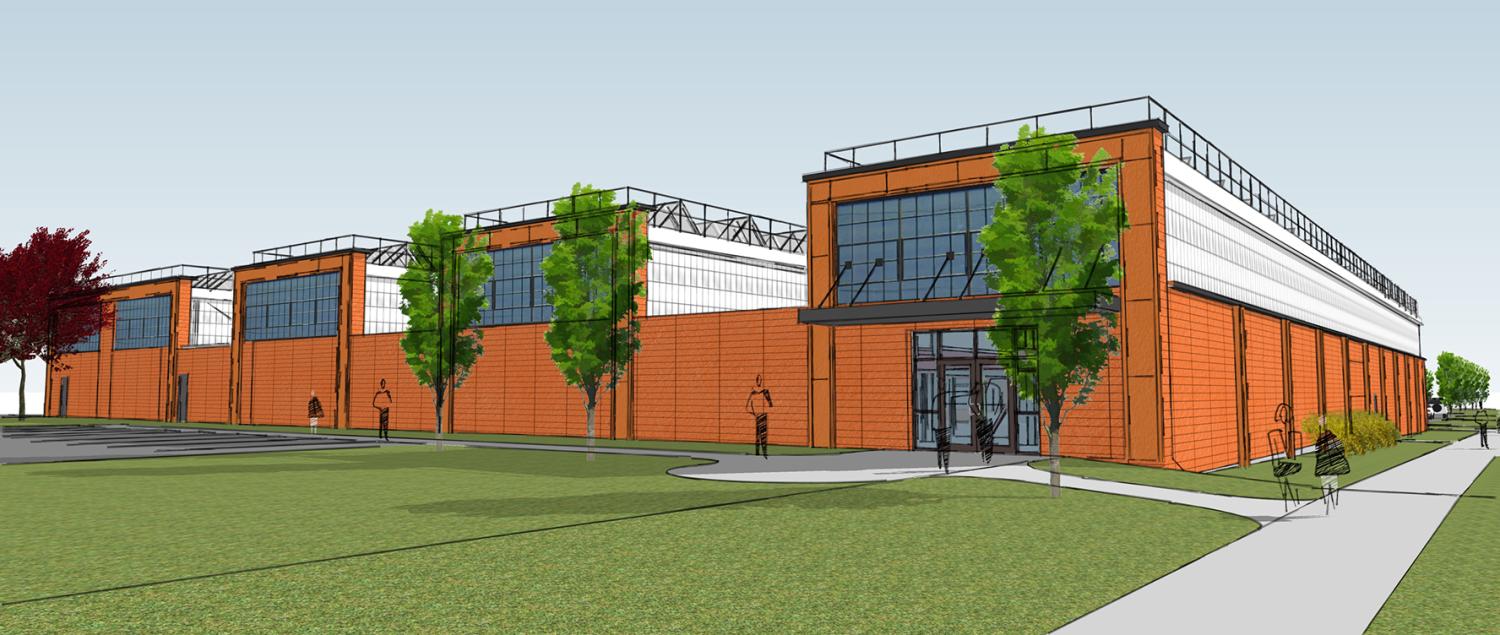
Making progress on infrastructure construction projects
BUDC has secured a design team for the Phase 3 building and announced it to the East Side neighborhood around NWTC. On top of funding from the BBBRC grant, the project has also received $55 million of state/ESD investment included in the 2022 state budget—part of which ($1.8 million) serves as the BBBRC match, with the rest going to additional projects on BUDC’s Northland campus. At this stage, BUDC is focused on seeing BBBRC projects to completion, due to the timeframe pressures to spend down BBBRC funds, and thus will not embark on state-funded projects until later. BUDC has devoted efforts to value engineering—assessing and adjusting plans based on what the commercial market wants in an industrial plan—and revising plans to reduce costs and make sure the project is financially feasible. Building plans will be reviewed by regulatory boards, with plans to go out to bid before March 2024.
The challenge of community engagement
The primary challenge around the infrastructure pillar is communication and setting expectations with a community interested in seeing immediate beneficial changes to their neighborhood. It was also a challenge that the BBBRC awards were made as community engagement and communication were normalizing, following a long stretch of little or no community activities during the pandemic. BUDC interacts regularly with the Northland Corridor Advisory Committee, which is comprised of community representatives surrounding Northland and other parts of the East Side to discuss the phasing of the infrastructure and concerns about community benefits. According to conversations that NWTC President and CEO Stephen Tucker had with East Side residents living near Northland, many feel that they are “still in the dark” about remediation initiatives. Others are “not satisfied” with the slow pace of visible progress and question why existing buildings are vacant and why they’re not seeing results. “There have to be more updates—that’s the biggest thing,” Tucker reflected. NWTC regularly engages in community-facing programming with partners, such as the Northland Beltline Taxpayers Association, local churches, and other community centers.
BUDC is making progress on the rehabilitation of three buildings on Buffalo’s East Side, which is expected to reduce neighborhood blight and provide space for advanced manufacturing businesses and local jobs. However, enhanced communication with community members is necessary to clarify community needs and convey the projected uses for these rehabilitated buildings, the timeline for these efforts, and how they relate to other neighborhood redevelopment efforts.
-
Innovation: Buffalo Manufacturing Works is supporting small and midsized manufacturers with tech implementation support and training
Buffalo Manufacturing Works (BMW) is providing small and midsized manufacturers (SMMs) with supports to overcome barriers to technology implementation as well as hand-on training for incumbent workers and high school students in related technology fields. This dual sector approach (with both the advanced manufacturing and tech sectors) appears to be meeting regional employers’ needs, judging by employers’ engagement. However, sustained employer engagement and readiness are still unknowns that will be critical to the success of the regional strategy.
Employer engagement is increasing, but requires continued nurturing
BMW has been seeing strong employer demand and engagement and is adapting its offerings to employers’ needs by meeting increased interest in and demand for “cobot” technology, especially post-pandemic. Cobots are designed to safely collaborate with humans and are outfitted with sensors, unlike industrial robots, which are built for speed and accuracy. BMW is actively working to help three SMMs in WNY implement cobot systems for metal parts finishing to increase efficiencies and take over ergonomically challenging parts of the manufacturing process. This approach somewhat mitigates concerns about job losses by both maximizing human expertise and increasing efficiency to get the work done.
Overall, BMW is ahead of schedule on implementation. BMW has also completed 48 business assessments as of October 2023 and formally brought 40 of them into the region’s Industry 4.0 ecosystem, as they have demonstrated engagement through participating in peer groups, incumbent worker trainings, and events.
Employer demand for these incumbent worker trainings continues to increase, as BMW has intensified its outreach process and its services have become more widely circulated. Companies have demonstrated particularly strong demand for the one-day training (compared to the five-day), including two companies that have inquired about buying out full one-day classes, which are projected to be implemented in 2024. And in response to companies’ feedback, BMW has also developed a two-day curriculum designed to provide participants with a more rigorous experience than the one-day introduction to automation, but without requiring as significant a time commitment as the five-day training (the first session was offered in late February 2024). In addition to this incumbent worker training, BMW has launched an after-school program at a high school in a Buffalo suburb to reach and engage younger audiences.
This employer engagement demonstrates early steps toward realizing a regional vision for business and workforce ecosystems that is closely informed by employers’ needs. Through the WNY MTW Coalition, NWTC’s Stephen Tucker will convene a council of employers and recruit “employer champions” in order to work toward a vision where employers “eventually have skin in the game.” Regarding the benefits of strong employer engagement, one private sector leader said, “I hope it’s the way we do business going forward,” as it reduces redundancies and promotes more efficient, effective use of funds.
Nevertheless, Karen Utz at ESD reflected that from the employers’ perspective, there may be skepticism. “Do the organizations understand how they fit together?” she said. “Are we organizing the trainings employers need? Are we getting the buy-in that we need from employers?” It is too early in the implementation process to answer, but these are undeniably critical questions that require continued scrutiny and will ultimately determine and drive the coalitions’ success.
Equity challenges in finding and including minority-owned businesses
It is harder for small and minority-owned businesses to benefit from the Shift 2.0 program. There are several hurdles that significantly reduce minority-owned business engagement and increase BMW’s difficulty in outreach. One barrier is that the process of acquiring a minority business certification is extensive and can take a long time in New York, resulting in a relatively low number of certified minority- and women-owned business enterprises (MWBEs). And MWBE certification is an important way for BMW to identify and recruit these firms. But this attenuated process is rooted in larger historical forces of segregation in communities (and therefore business networks) as well as the related factor of fewer MWBEs in manufacturing than in other sectors. Yet according to BMW, until businesses are certified as MWBEs, it is difficult—if not impossible—to treat them as such. Because there are few certified minority-owned SMMs, BMW is engaging in extensive outreach to identify and engage MWBEs. Additionally, successful outreach and engagement require rebuilding trust, as many MWBEs have been hurt by past patterns of discrimination and disinvestment. All in all, this challenge of identifying MWBEs is particularly salient for construction firms, as they attempt to hire MWBEs for ongoing projects.
In implementing the BBBRC innovation pillar, BMW is building on its core work providing tech support and training to SMMs to help them implement new technologies. BMW’s focus on increasing employer efficiencies through specific trainings—such as cobot implementation projects—remains part of the larger goal of bringing the region’s SMMs into an Industry 4.0 ecosystem. While these efforts are meeting some equity challenges, BMW’s employment engagement efforts and collaboration with NWTC are driven by the regional vision that business and workforce ecosystems can be more closely informed by employers’ needs and meet greater equity outcomes.
-
Governance and organizing across WNYAM and WNY MTW coalitions
While formal coordination of the BBBRC projects does not happen regularly (as WNYAM is not funded to have an official governance structure), the high level of pre-existing relationships and networking among key organizations means there is substantial informal coordination that allows WNY leaders to collaborate with each other, including in developing the WNY MTW Coalition. By all accounts, the individual implementing organizations are managing the three BBBRC projects well, and grantees say they organize themselves to discuss success stories, strategize, and coordinate reporting and storytelling. Moreover, the related WNY MTW Coalition’s governance structure—with its clearly defined leadership structure, including the subsequent decision to establish and fund a WNY MTW Coalition executive director (NWTC President and CEO Stephen Tucker) and a senior project lead (at CRS) to support the coalition and focus on strategy—fills an intermediary organization gap in the workforce pillar.
Overall, governance and oversight efforts of the informal WNYAM structure are reliant on resources provided through other efforts—such as ongoing state initiatives and the WNY MTW Coalition—to essentially cover the time and effort required to connect the BBBRC projects. However, WNYAM organizations and their leaders (e.g., Henry Cialone at BMW; Tom Ulbrich at Goodwill of WNY; and the BUDC staff) are already key players in Buffalo and the WNY region, and are well networked within the community as well as with the state and philanthropy, enabling WNYAM partners to build a broader regional strategy.
Implications
While there are multiple years left in both the WNYAM and WNY MTW grant periods, the region’s early progress offers critical insights, as laid out below in the five emerging implications for economic, community, and workforce development practitioners and policymakers. Both coalitions are testing new approaches to regional collaboration aimed at reversing downward economic trends and jump-starting inclusive economic growth in a region with both urban and rural areas that face long-standing challenges. The WNY MTW Coalition’s dual sector strategy—blending advanced manufacturing and tech training to reflect business employment demands and the realities of workers’ skills and training needs—is just launching and will be woven into a full workforce and economic development regional strategy. As these pilot efforts continue in the coming years, it will be important to monitor them for their effectiveness and long-term sustainability.
-
The two synergistic coalitions demonstrate how equitable economic and workforce development strategies can achieve relevance at multiple geographic scales, from outlying rural areas to low-income inner city neighborhoods.
These two coalitions provide a unique opportunity to demonstrate ways to overcome barriers to training and inclusive economic growth with tailored, community-shaped strategies that are also informed through regional sharing across rural and urban areas. For example, in the more densely populated city of Buffalo, NWTC has crafted and implemented strategies to embed itself in the neighborhood—rebuilding trust that institutions have lost due to decades of racial exclusion and segregation, and directly engaging local organizations through community programming to reach historically excluded populations. On the other hand, in the Southern Tier, JCC has focused less on strategic outreach and more on directing resources to wraparound services such as transportation needs and other supports that uniquely affect rural residents. Notwithstanding these differences, the rural and urban areas also have much to learn from each other and are now well positioned to do so, particularly with the WNY MTW Coalition deliberately bringing in multiple new collaborators from the rural Southern Tier.
-
This case study illustrates the synergies and tensions that can arise from physically siting new regional economic assets within underinvested neighborhoods.
Redevelopment of abandoned buildings—such as the NWTC building previously completed with state Buffalo Billion funds and additional buildings being reconstructed under the WNYAM project—offer significant community benefits as neighborhood anchors, such as blight elimination and the subsequent positive impact of installing new productive uses in the buildings with local employment opportunities. However, as community feedback demonstrated, systemic equity issues and distrust do not disappear overnight. As they are completed, these physical infrastructure reuse projects will need to continue to undergo significant community review as the subject of community meetings, with clarity on timelines for completion and reuses. At the coalition level, WNYAM partners will need to better articulate how the buildings’ uses tie back to strategic workforce and economic development outcomes.
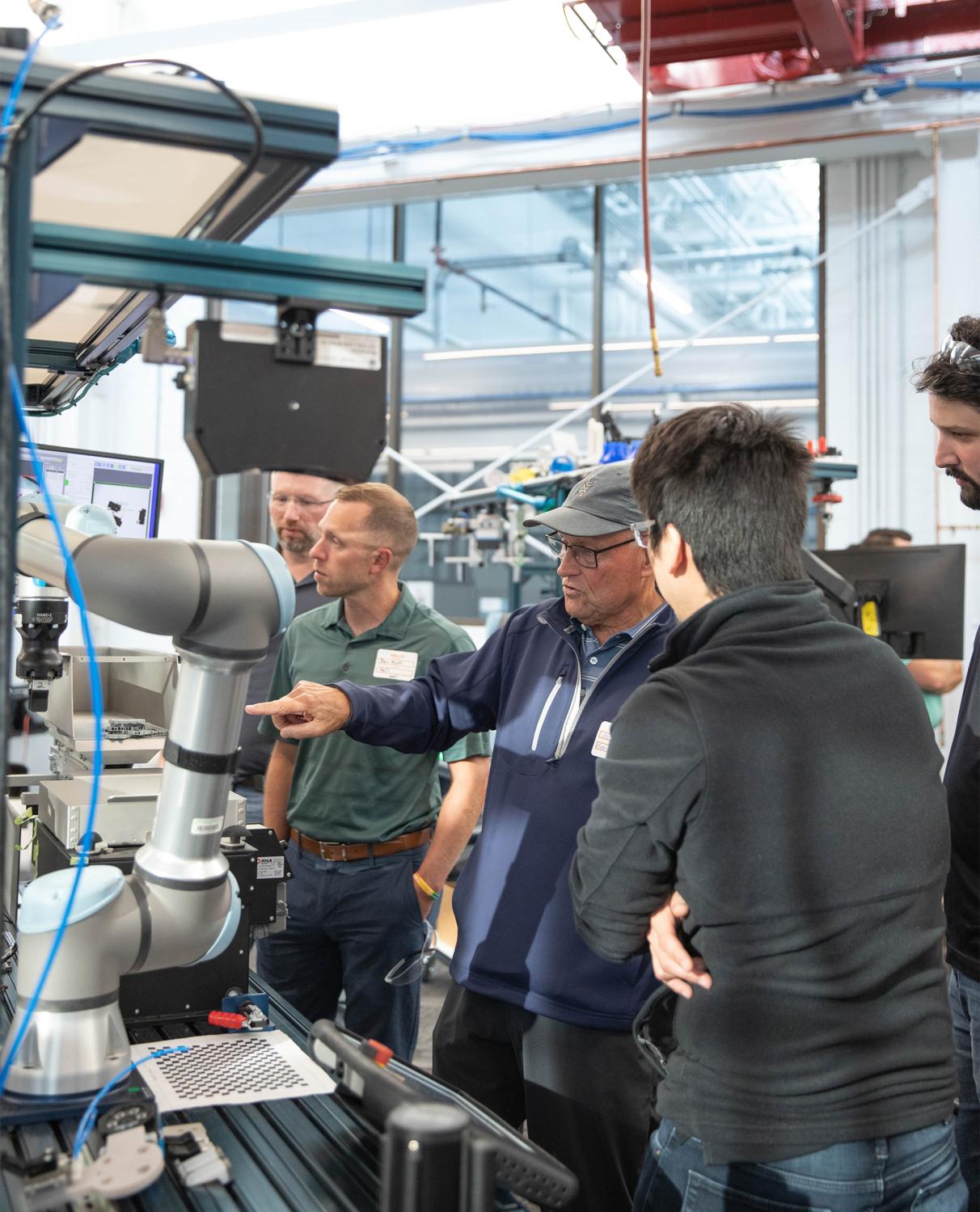
-
The large, one-time infusions of federal, state, and philanthropic resources into Western New York’s institutions are forcing new considerations around organizational sustainability.
The potential for program and organizational sustainability varies across projects and intermediaries depending on factors such as mix of funding, revenue sources, and the nonprofit business model and its strategic approach. Such a large infusion of philanthropic and public dollars to fund intermediaries designed to jump-start a stalled economy is generally not sustainable. The ultimate viability of the funded organizations and their sustainability depend on a range of factors, including the mix, type, and degree of sources (i.e., public versus philanthropic versus private); the entities’ business operating models; and who the intermediary is serving. BMW, which has been primarily funded through state ESD and now federal EDA funding, recently adopted a five-year strategic plan that expects about 30% of its operational budget to come from the public sector.
BMW and NWTC—both founded and supplied with ongoing public funding, and now bolstered with subsequent philanthropic support leveraging the original public investments—are likely to have more sustainability pressures than, for example, an organization such as TechBuffalo, which was founded primarily with private sector partners along with some philanthropic support. Nevertheless, programs such as TechBuffalo may be expensive and labor-intensive compared to overall outcomes in terms of number of trained workers, and may need to be modified or scaled accordingly—particularly if private sector partners do not remain heavily involved. Finally, Goodwill of WNY’s Goodskills program stands out for finding independent revenue sources; it builds out of its retail infrastructure, the profits from which can fund the workforce work. The program’s goal is to be 95% self-funded by 2030. All these considerations are critical as the region’s largest philanthropic supporter, the Wilson Foundation, sunsets in 2035. Therefore, these intermediaries must continue to seek ways to generate independent revenue and create self-sustaining revenue models, unless they can expect regular public or philanthropic infusions.
-
Piloting and innovating new sustainability approaches have already resulted in WNY intermediaries developing new models that have replication potential and are attracting interest for adoption within and outside New York.
Because the intermediaries predated the launch (as a result of Buffalo Billion funding) and implementation of either coalition, the additional boost of funding is further transforming them. As these nonprofit organizations test new ways of doing business and strategic planning, they are attaining new levels of maturity with potential for replicability. For instance, scaling up NWTC’s model would offer new sustainability opportunities, especially given its demonstrated effectiveness—a completion rate more than twice as high as three-year completion rates at community colleges. Whereas previously, State University of New York community colleges had been skeptical there would be student demand, one public sector official said, “Now they’re advertising Northland as one of the premier programs that they offer.” A recent announcement by New York Governor Kathy Hochul called for a new funding program for training centers across the state that apply the approach first developed at NWTC.
The region is also seeing synergies among the myriad of federal programs that are touching Upstate New York. For instance, cross-regional discussions arising from the National Science Foundation’s Regional Innovation Engines program led BMW to have conversations about replicating Shift 2.0 in regions outside Buffalo, including in Rochester, N.Y. and a Midwestern location. While its business model would not support opening a full operation at another site, BMW is exploring potential partnerships with organizations in other localities within driving distance (e.g., Rochester), where they can offer incumbent worker trainings that are more accessible to workers in those areas.
Finally, the coalition-based funding (e.g., the state’s funding of the WNY MTW Coalition) has been discussed as an alternative funding track for ESD/OSWD-funded programs in other New York regions, with the idea of coalitions growing into a community of practice. The individual WNY MTW Coalition grantees worked closely with the Wilson Foundation and UBRI to creatively design their separate grant applications and demonstrate their relationships using strong common language so that the coalition members would be easily identifiable as a coalition in practice.
-
The WNY coalitions exemplify how active philanthropic and state investors can complement federal place-based grants to drive greater scale.
These regional coalitions are fostering inclusive networks that will be critical to renewed economic growth by extending programs and projects to transcend urban-rural divides and cross historical residential segregation boundaries in the heart of Buffalo. Pre-existing cross-sector relationships, intentional network-building, and state and philanthropic funding have set up the region’s WNYAM and WNY MTW coalitions to drive successful regional economic growth. While WNYAM does not have an EDA-funded regional economic competitiveness officer (RECO) governance infrastructure, the synergies with the WNY MTW Coalition show the unique power of state and philanthropic efforts to fund and curate a strong regional strategies by facilitating knowledge exchange, peer learning, and relationship-building—all enabling the intermediary organizations to reduce redundancies and leverage existing resources. Only by addressing underlying racial, socioeconomic, and geographic inequities will the region harness its full economic potential.
Conclusion
The cascading tranches of funding that have flowed into WNY over the last five years—on top of the Buffalo Billion—are already having cumulative effects. Now, building on that robust foundation, the BBBRC federal investment complements additional public and philanthropic investments: $55 million from ESD for Northland construction projects and $29 million from OSWD and the Wilson Foundation for workforce components across the WNY region.
This blended funding is further strengthening the region’s intermediaries (e.g., NWTC, BMW) and fortifying their work. It has also renewed East Side community interest and advocacy by revitalizing neighborhood information-sharing and advocacy groups. Alongside Goodwill of WNY’s Goodskills project, the WNY MTW Coalition is positioned to drive new regional workforce efforts—marking an unprecedented level of collaboration across the region through formal participation by JCC and MAST—and leverage these relationships to build out its goal of a knitted-together, long-term regional workforce ecosystem strategy. As the region gains economic momentum, this layering of funding is positioned to attract more private sector investment—complementing the augmented work of local intermediaries as they find ways to support themselves and sustain their programs.
EDA case study series
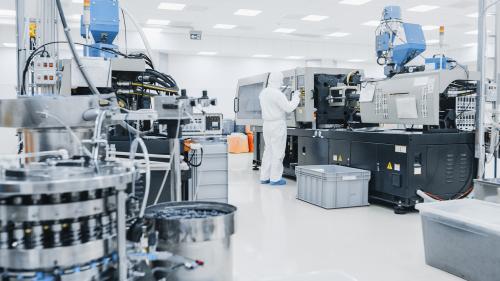



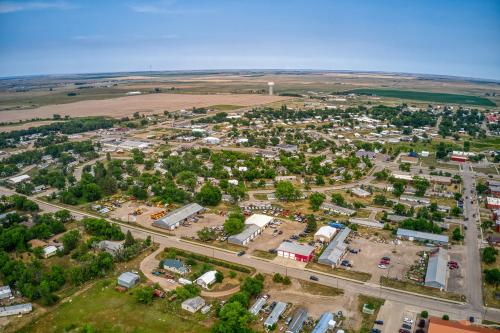
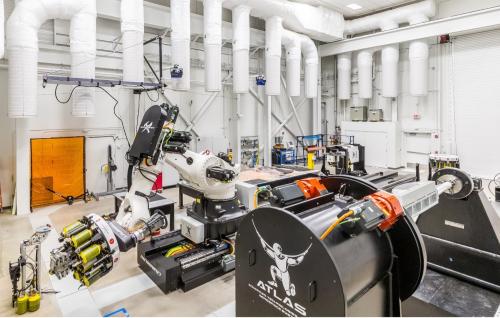
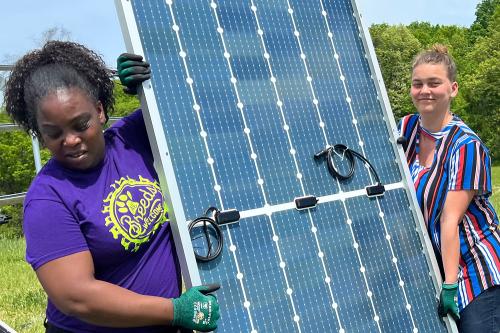
-
Acknowledgements and disclosures
The Brookings Institution is a nonprofit organization devoted to independent research and policy solutions. Its mission is to conduct high-quality, independent research and, based on that research, to provide innovative, practical recommendations for policymakers and the public. As such, the conclusions and recommendations of any Brookings publications are solely those of its authors, and do not reflect the views of the Institution, its management, or other scholars.
Brookings recognizes the value it provides in its absolute commitment to quality, independence, and impact. Activities supported by its funders reflect this commitment.
The authors thank Alex Jones, Bernadette Grafton, Ilana Valinsky, Ryan Zamarripa, Suyog Padgaonkar, Scott Andes, and Justin Tooley from the Economic Development Administration for their insights into the Build Back Better Regional Challenge and for their guidance throughout the development of this case study. For their comments and advice on drafts of this paper, the authors also thank our colleagues Joseph Parilla, Hanna Love, and Glencora Haskins, as well as Laura Quebral (Center for Regional Strategies), Paul Tronolone (Empire State Development), and Susan Dundon (Ralph C. Wilson, Jr. Foundation). The authors also thank all local leaders, community-based organizations, economic development practitioners, regional intermediaries, higher education institutions, industry representatives, and other coalition members who participated in informational interviews and site visits throughout this project, and who provided feedback on the research insights and policy recommendations detailed in this report.
This report was prepared by Brookings Metro using federal funds under award ED22HDQ3070081 from the Economic Development Administration, U.S. Department of Commerce. The statements, findings, conclusions, and recommendations are those of the author(s) and do not necessarily reflect the views of the Economic Development Administration or the U.S. Department of Commerce.
About Brookings Metro
Brookings Metro collaborates with local leaders to transform original research insights into policy and practical solutions that scale nationally, serving more communities. Our affirmative vision is one in which every community in our nation can be prosperous, just, and resilient, no matter its starting point. To learn more, visit www.brookings.edu/metro.
-
Footnotes
- Economic Development Administration. “FY 2021 American Rescue Plan Act Build Back Better Regional Challenge Notice of Funding Opportunity (NOFO) (ARPA BBBRC NOFO).” U.S. Department of Commerce. https://www.eda.gov/arpa/build-back-better https://www.eda.gov/arpa/build-back-better
- Ibid.


